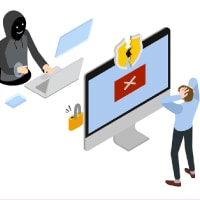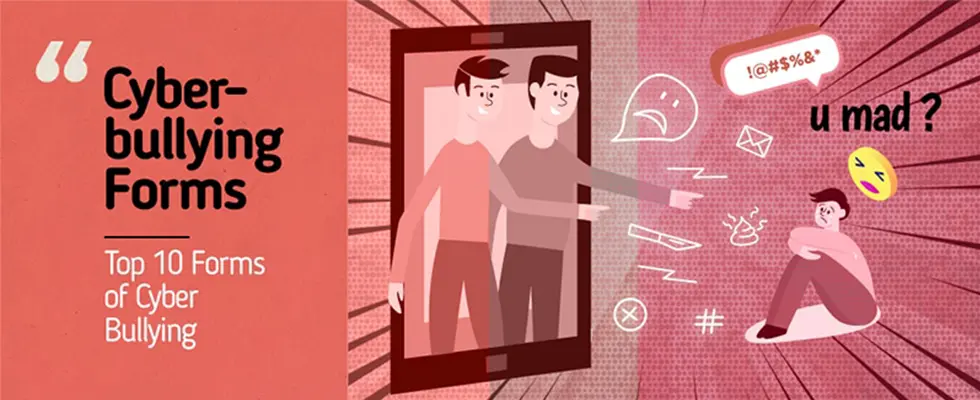The month of October is known for National Bullying Prevention Month, and school in the United States is raising their Voice against the bullying online and also educates about the prevention methods. However, before we dive into the prevention methods, parents should know about what is cyberbullying. Bullying online is a worldwide problem that’s growing fast. In this particular blog post, we will take you to the top forms of cyberbullying. It would further help you out to protect your children. We are going to discuss the major forms of online bullying that can make your child a victim of online predators.
What is Cyberbullying?
The use of digital communication in terms of cellphones and internet to make someone angry or provoke anyone to get cruel response, sad, or sacred back and forth is known as cyber bullying. So, online bullying comprises to sending hurtful messages, text messages, instant messages, posts, sharing someone’s private photos, videos on social networking and last but not the least spreading rumors against someone online to damage the reputation of the target is known as cyber bullying.
Top 10 Forms of Cyberbullying
There are the following forms of cyber bullying that parents need to know, and they can advise kids about them to prevent themselves from online abuse to the fullest.
Exclusion

Put a stop to cyber bullying and protect your children from all kinds of online predators. Use cell phone parental monitoring software and make sure that your child is safe online fully. Most of the parents who ignore are reportedly kept themselves bitching because of their irresponsibility. Be a responsible parent and protect your teens and kids from cyber predators.
Harassment

It is continuous and intentional bullying that leads to abusive and threatening text messages sent to your kids or the group. This can be serious effects on child mental bullying.
Outing

It is an act of openly embarrassing a child or group through the online posting of private or embarrassing information without asking the victim. Even reading your child’s text messages out loud is known as an outing.
Cyberstalking

It is one of the most dangerous forms of cyber bullying in which attackers threaten victims through social communications such as email, social media apps, and instant messengers. It also comprises to adults using the cyberspace to contact and meet young kids and teens for abusive aims.
Fraping

It means when anyone gets ingress to your child’s social media account and then pretends as your child and post inappropriate content on their behalf. Parents should keep in mind that everything humiliating or posted online can never be fully gone no matter what if deleted.
Fake Profiles

Fake profiles can be created to hide someone’s real identity to make a child a victim of cyber bullying. Online bullies can use someone else email, social media platforms, and mobile phones to harass them.
Dissing

It means sending or posting inappropriate information about your child online to break their reputation and their friendships. It also includes posting damaging photos, screenshots or videos online.
Trickery

It involves winning your child’s trust initially so that the secrets can be shared publicly online. Cyberbully will defend your child in front of others leading him into the false sense of security before sending their secret information to others.
Trolling

It means willingly ousting someone’s response through the use of humiliation on social media apps and instant messaging apps. A trolley will himself encounter with your child to make them angry and tease them to get a negative response.
Cate fishing

It means grabbing someone’s online identities and then reestablishing social networking profiles for dodging purposes. So, catfishers look at your child’s social media profiles and steal information to create a fake image. This could involve using personal information vulnerable to damaging your child’s online reputation.
What Is The Relation Between Traditional Bullying & Online Bullying?
A new study from the University of Florida says that 80% of the students are cyberbullying victims. They are more likely to experience bullying at school as well. Boys and girls used to troll their fellows at school are more likely to perform bullying on the web. It means that traditional bullies have adopted technology to extend their activity using verbal, non-verbal tactics.
Cyberbullying laws that parents need to know
Laws related to online bullying are different from state to state worldwide. Governments worldwide have come up with serious concerns about cyberbullying, and they have introduced new laws. Covid-19 has increased the bullying online because kids and online predators are spending more time in the digital world.
eSafety Commissioner in Australia has unveiled stats given below:
- 1 out 5 kids in Australia become the victim of harassment online via social networks
- 20% of Australian kids become the witness and involved in bullying online
- Every young online bully have experienced cyber bulling one way or the other
- 55% of Australian becomes the victim of online abuse, solicitation and 38% blocked the online predators
- 28% of kids have got advice from parents after interaction with cyber predators
- Only 12% of the kids have reported about social media authorities
The Australian authorities have announced that there are no legitimate laws related to bullying online. The government has advised that young kids should keep logs of bullying that take place on social media or somewhere else. It would help to prosecute the culprits under the criminal code, 1955 related to telecommunication crimes.
According to the Statistics
The adoption of social media and technology all across the glove has finally opened the doors for a new type of bullying that is known as bullying online. The online harassment these days is one of the biggest concerns for parents due to the following reasons.
- It can happen around the clock
- The new type of bullying or cyberbullying could last longer because things these days are associated with only posting that can remain longer.
- The detection of cyberbullying or harassment is very difficult unlikely bullying, it happens under complete silence, which makes it harder for parents to know it about.
Cyberbullying is a continuous problem
Almost 95% of the teens are connected to cyberspace and 85% of teens are on social media apps and websites, according to the study of PEW Research Center. Seemingly, it is a good sign that teens are getting enough piece of knowledge from the internet. However, at the same time teens are more likely to get engaged or have encounters with the harmful interactions, and online bullies.
Almost 73% of young students do believe that at some point of they got bullied online, and 44% say it happened in the last 30 days.
Where teens mostly got bullied online?
- 42% of the teens got bullied online on the Instagram social messaging app
- 37% of teens encounter with the cyber predators on Facebook
- 31% of kids have experienced digital bullying using Snapchat
- 12% of the youngsters have faced bullying online on WhatsApp instant messenger
- 10 % of teens on YouTube and 9% become the victims of harassment on Twitter.
According to the StopBullying.GOV, 69% of people according to the report bullied someone in the cyber world. However, 15% have admitted that they bullied people online.
Effects of cyberbullying on kids
- 41% of the victims have got social anxiety
- 37% have been developed depression
- 26% have got suicidal thoughts in mind
- 26% have removed their social media profiles
- 25% have harm themselves being a victim of online predators
- 9% have become substance abusers
Bullying online is a massive social problem
The very interesting thing about it does not remain exclusive to teens only, these days adults have also become the victims of cyber predators. However, still bullying in the cyber world is specifically associated with teens and children because they cannot help themselves but adults can. Let’s get to know about the forms of cyberbullying that gives you the knowledge to protect teens.
Is There Any Ratio Difference Between Boys & Girls Cyber Bully Victims?
Yes, there is a little ratio difference between the girls and boys victims of online bullying. Few experts do believe that boys are more likely to become the victim of cyberbullies. However, few say teens are the victims of bullies online compare to young boys. Look at the following stats!
Pew Research Center stats:
- 60% of young girls experience cyber bullying one way or the other
- 59% of young boys become the victim of online bullies via different online mediums
Difference lies between the forms of bullying: Boys VS Girls
- 39% Girls face humiliated rumors about them online, like Lesbian
- 26% boys face false rumors about them like Gays & transgender
- 29% of young teens receive random sexually explicit messages
- 20% of boys receive explicit messages & images
According to the Swedish study, teens are more likely to become cyber bullies victims because of their physical appearance. It means that gender does not differentiate to become a victim of cyber bullying. The study has further added that people belong to the lower-income class, LGBTQ, and obsessed with the digital world are more likely to become the victim of online predators.
Solution:
Put a stop to cyber bullying and protect your children from all kinds of online predators. Use cell phone parental monitoring software and make sure that your child is safe online fully. Most of the parents who ignore are reportedly kept themselves bitching because of their irresponsibility. Be a responsible parent and protect your teens and kids from cyber predators.







